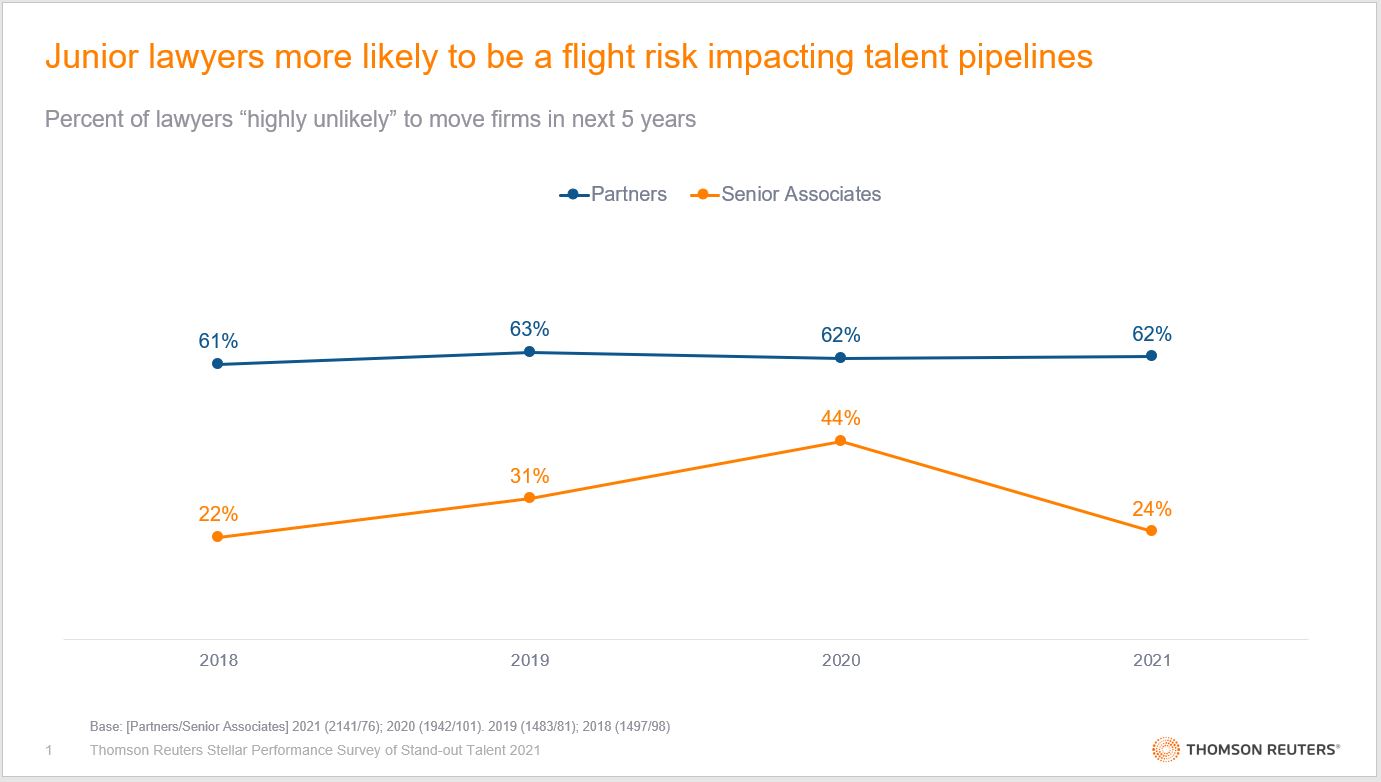What can law firm leaders do to ensure their top legal talent remain with the firm and flourish while they are there?
Quality talent has been — and always will be — a law firm’s most valuable asset. Yet only 60% of lawyers say they are “highly unlikely” to leave their firm within the next five years, which means that a stunning 40% of lawyers are flight risks.
This risk to law firms is only amplified when we look at the talent development pipeline in which we see that the rate of flight risk for non-partner lawyers is much higher.

Even though lawyer flight risk levels have remained fairly steady over the years, this potential turnover can be an expensive liability for law firms that would be better served investing resources in new — not replacement — talent.
Rather than focus on the drivers of lawyer dissatisfaction, our recent research with stand-out lawyers looked to uncover the commonalities of the most satisfied and engaged lawyers. We looked to the 56% of law firm lawyers who rated their satisfaction a 9 or 10 out of 10 when it came to their working lives.
We found that these most motivated lawyers are:
-
-
- 4 times more likely to commend the culture of their firm;
- 6 times more likely to applaud their firm for being collegial and collaborative;
- 6 times as likely to talk about their firm’s ability to treat people fairly and with respect; and
- 3 times as likely to say their own values align with their firm’s values and ethos.
-
However, these strongest drivers of employee engagement also are those most under pressure by the continuance of remote or hybrid working that greatly expanded during the pandemic. Building a firm-wide culture or collegial environment is difficult under normal conditions, but trying to do this through a computer screen is infinitely more difficult.
In fact, managing a hybrid work environment is also an area where lawyers see room for firm leadership to improve.
Leadership’s role in engagement
When it comes to leading a law firm that is utilizing remote or hybrid conditions, lawyers say there’s more that can be done.
According to our research, lawyers say that communication is at the core of what leadership can do to help make a hybrid or remote working model more successful. Of course, much like communicating with clients, there is no one-size-fits-all approach to how lawyers want this communication to happen. Suggestions from lawyers ranged from individual check-ins to more virtual meetings, to using electronic newsletters — with no one method being a majority preference.
For leadership, the important takeaway is not so much the method of communication, but instead it’s what better communication provides in terms of lawyer support. These include:
-
-
- a feeling of connection to the larger firm entity;
- insight into what’s happening at the firm, such as successes and key changes being made;
- an invitation to add their voice, both formally and informally, into their role in the firm’s strategy; and
- tools and tactics for better well-being management.
-
Right now, law firm leaders are in the unique position to provide greater clarity to their employees with more controlled, thoughtful communication. And our research on lawyer well-being shows that clarity is a critical element of high engagement and positive well-being.
For those law firms able to get this right, the results are happier, more loyal employees — which in turn, our research shows results in happier, more loyal clients.
For more on how you can best challenge and evaluate your talent management strategies, see our 2021 Thomson Reuters Stellar Performance mid-year survey, now currently live.







